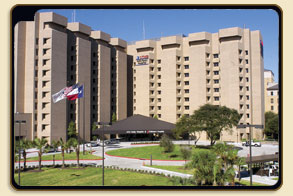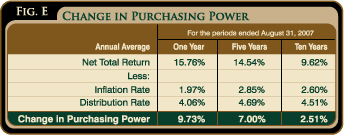|
Distribution (or Spending) Policy
 |
|
The University of Texas Medical Branch at Galveston
|
The distribution rate of the LTF is based on a distribution policy that balances the needs and interests of current beneficiaries with those of the future. The LTF utilizes what is often called a "constant growth" spending policy in determining the annual distribution rate. Under a constant growth spending policy, the distribution rate in any year is equal to the distribution rate in the prior year plus an increase to offset actual inflation. Thus, the distribution rate grows at a steady rate equal to the rate of inflation, providing a stable stream of "real" resources to the beneficiaries of the endowments in the LTF. Total distributions from the LTF increased by $19 million during the year, from $180 million in fiscal year 2006 to $199 million in fiscal year 2007. This increase is a result of the increase in the distribution rate, and additional contributions received during the year.
The LTF's distribution policy defines the compromise between the conflicting goals of providing substantial, sustainable support for current operations and preserving purchasing power of the endowment assets for future generations. The LTF's distribution policy objectives are an integral element in the success of the LTF preserving its purchasing power. The LTF distribution policy was designed to meet the following objectives:
1. Provide a predictable, stable stream of distributions over time.
2. Ensure that the inflation adjusted value of distributions is maintained.
3. Ensure that the inflation adjusted value of LTF assets after distributions is maintained over the long-term.
The LTF distribution rate is increased annually at the average rate of inflation (twelve-quarter average) provided that the distribution rate remains within a range of 3.5% to 5.5% of LTF net asset value. The LTF's distribution rate per unit increased from $0.2510 to $0.2844 per unit or by 13.3% on a nominal basis over the five-year period ended August 31, 2007. The increase in the distribution rate per unit, coupled with the fluctuation of the LTF's net asset value per unit, resulted in a distribution rate of 4.2% of the LTF's twelve-quarter average net asset value in the 2007 fiscal year.
As depicted in Figure E, the LTF has achieved its objective of maintaining its inflation adjusted value because it has increased its purchasing power over the ten year period by 2.51%. Fiscal year 2007 provided real growth in the LTF of 9.73%. This growth is retained in the LTF to offset years, when investment returns trail the inflation rate and purchasing power is not maintained. Controlling the LTF's distribution rate in years when the LTF has experienced above average asset growth has allowed the LTF to follow its distribution policy and thus increase distributions at the rate of inflation even in periods when actual returns are below average.

Click to print charts in this section using PDF format
|